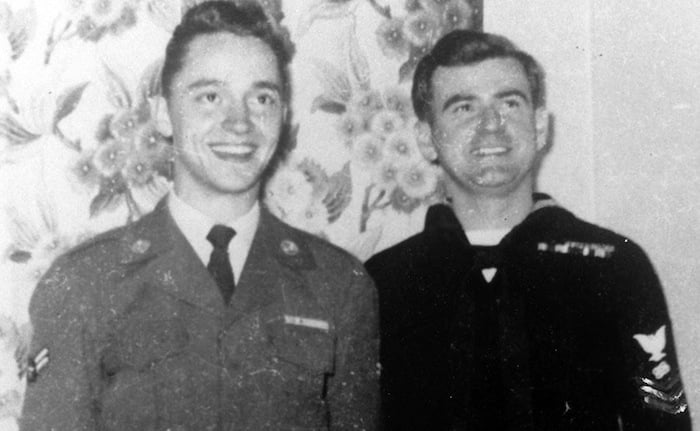
Chuck Schoen, right, and life-long friend Jack Bickell pictured in a photo from the 1940s. In 1942, Schoen enlisted in the U. S. Navy, where he met his partner of 48 years, Jack Harris.
Scheon was discharged from the Navy after 19 years of service and eventually formed groups fighting for the rights of gay and lesbian veterans. Photo courtesy the Chuck Schoen Collection at the ONE Archives at the USC Libraries.
For almost 70 years, Uncle Sam was emphatic — We don’t want gays and lesbians in the U.S. military.
Despite serving their country with honor, gays and lesbians were routinely kicked out of the armed services because the federal government said homosexuality was “incompatible with military service.”
Lesbian News founder Jinx Beers to be inducted into LGBTQ Journalists Hall of Fame
ENDING BAN ON GAY, LESBIAN SERVICEMEMBERS
In December 2010, the Don’t Ask, Don’t Tell Repeal Act of 2010 created a complicated pathway for gays and lesbians to openly serve in the military.
According to the bill, the “Don’t ask, don’t tell” policy remained in place until the President, the Secretary of Defense, and the Chairman of the Joint Chiefs certified that the repeal wouldn’t harm military readiness, followed by a 60-day waiting period.
A court order on July 6, 2011, ordered the Pentagon to immediately suspend the ban. The repeal finally took effect Sept. 20, 2011.
ALSO READ: First LGBT veterans memorial could be located in California
GAYS, LESBIANS IN WORLD WAR II
The persecution and struggle gays and lesbians faced in the U.S. military during World War II is examined in Allan Bérubé’s “Coming Out Under Fire,” which draws on G.I.s’ wartime letters, extensive interviews with gay veterans, and declassified military documents.
Bérubé’s book inspired the 1995 Peabody Award-winning documentary of the same name.
During World War II, gays and lesbians found themselves fighting two adversaries — the Axis Powers and their own government, which took extreme measures, starting in 1942, to stigmatize them as unfit to serve their country.
At the start of World War II, the U.S. military, desperate to meet enlistment quotas, quietly admitted gay people with the implicit understanding that they would be discreet about their sexuality.
For many gay men and lesbians, Bérubé wrote, military service was actually an escape. They left their small-town lives and had their first opportunity to meet other gays and lesbians.
FINDNG GAY LOVE IN THE MILITARY
Some of them also found love.
In 1942, Chuck Schoen enlisted in the U. S. Navy, where in met his partner of 48 years, Jack Harris.
Scheon was discharged from the Navy in 1961 after 19 years of service and eventually formed Redwood Empire Veterans C.A.R.E. (Council for American Rights and Equality). In 1985, Schoen and Harris created a 50-foot long U. S. flag for Veterans C.A.R.E. to use in Gay Pride parades.
In the 1990s, Schoen founded the Gay, Lesbian, Bisexual Veterans of America, later renamed American Veterans for Equal Rights.
Schoen’s personal collection of letters, photos, and momentos documenting his service and activism are housed at ONE National Gay and Lesbian Archives at the USC Libraries.
FROM FREEDOM TO WITCH HUNTS
Bérubé said that those early years of World War II were the wellspring of the gay-rights movement of the late 1960s and beyond.
In general, Bérubé said, gay and lesbian service people who excelled at their jobs were treated well by their fellow soldiers and superiors.
Conditions, however, worsened toward the end of the war, when the military escalated its purges of gays and lesbians. The witch hunts destroyed many lives and careers.
